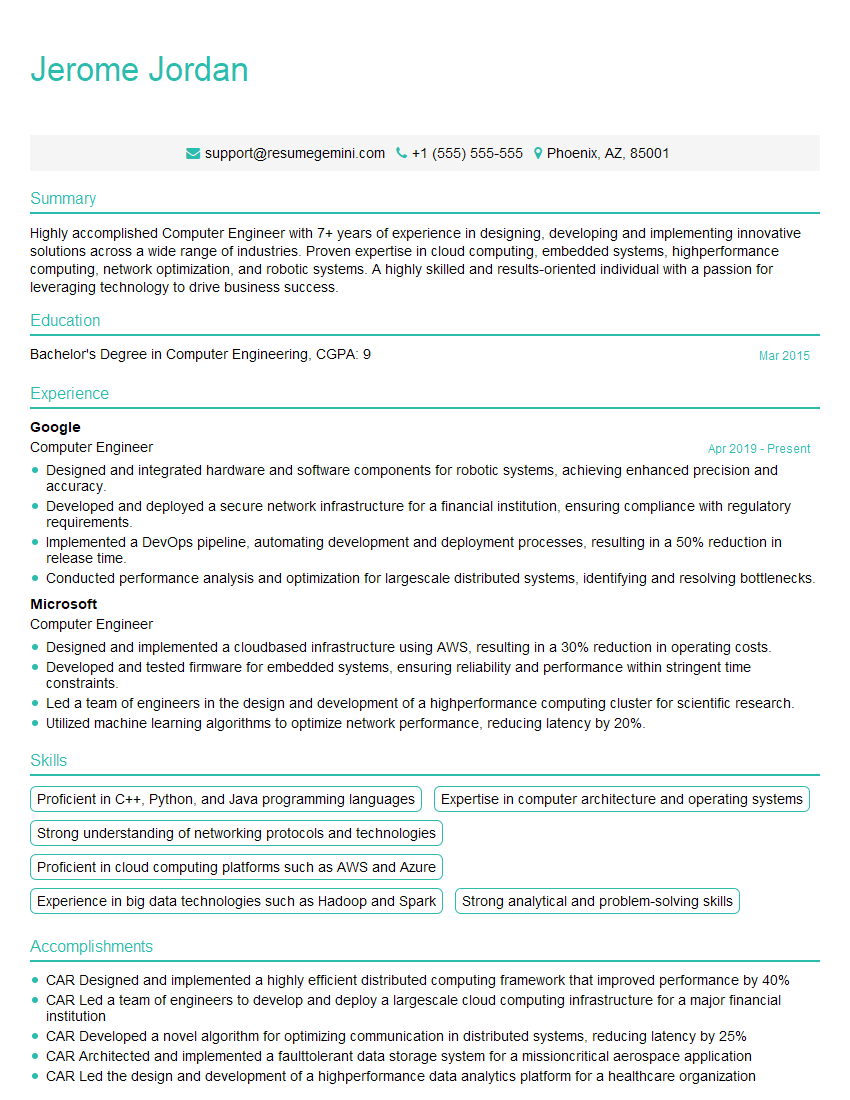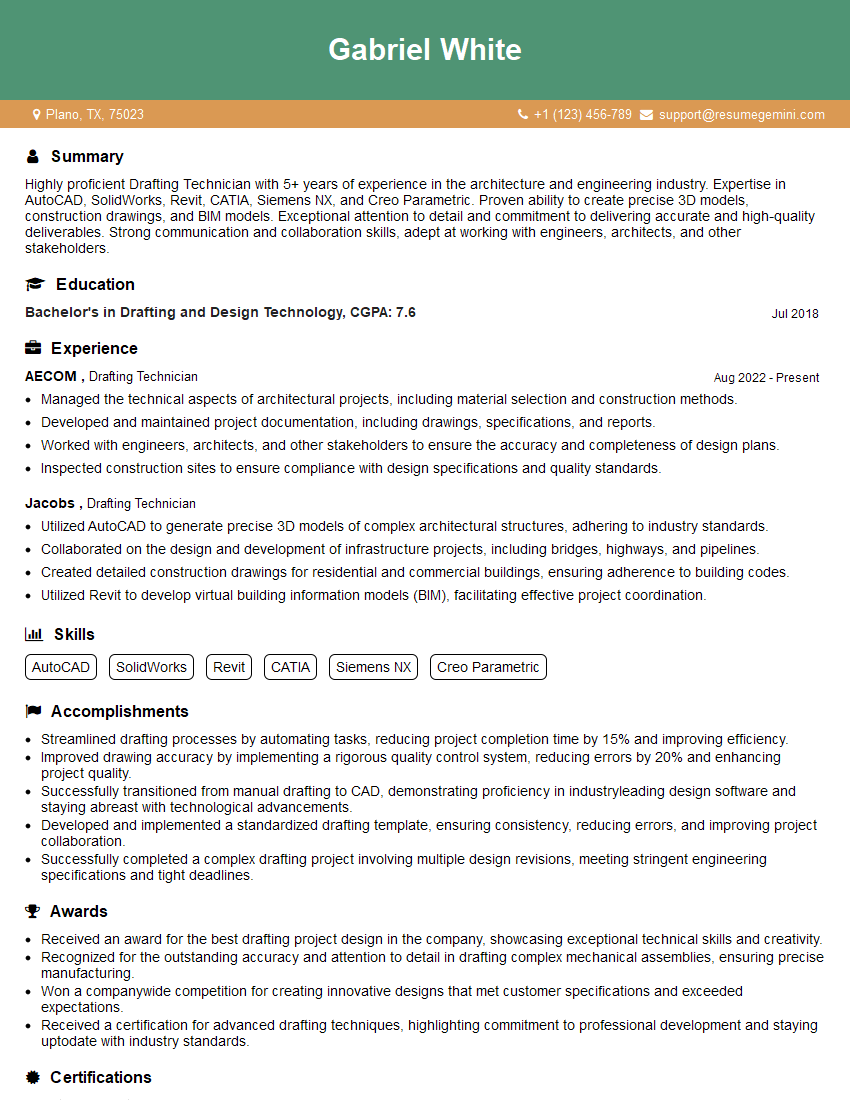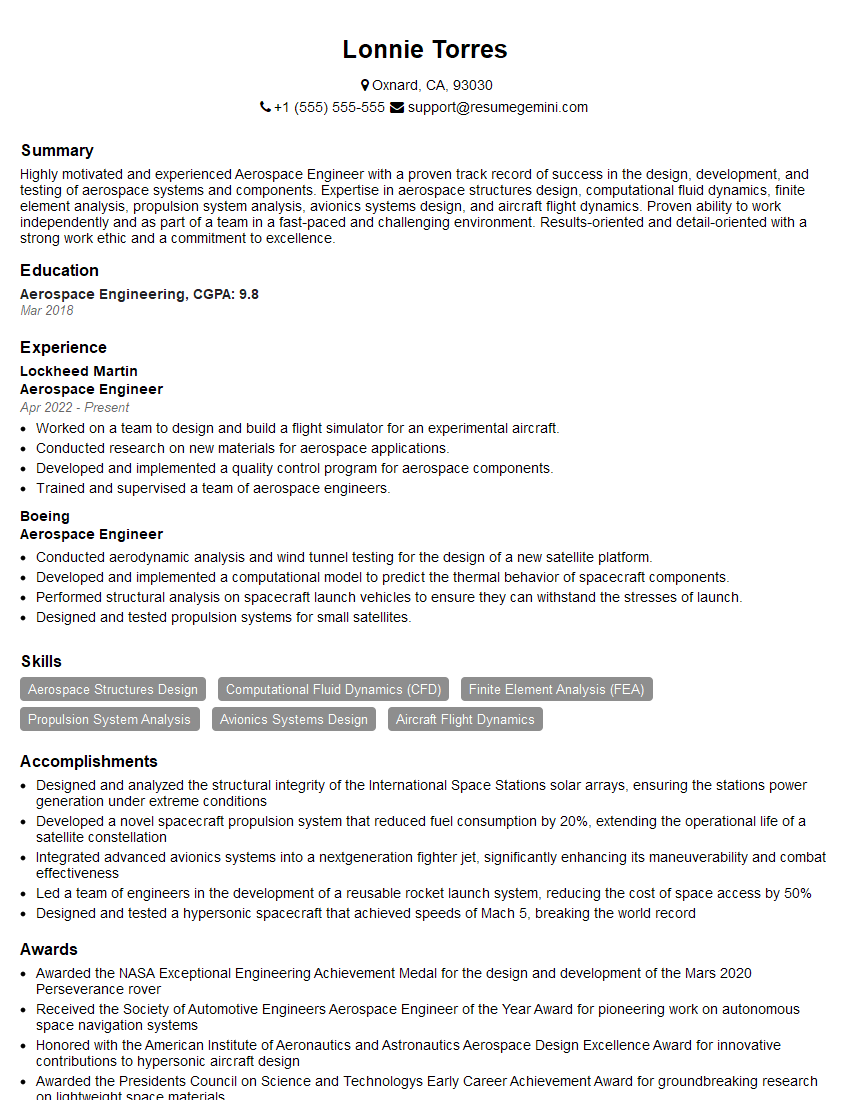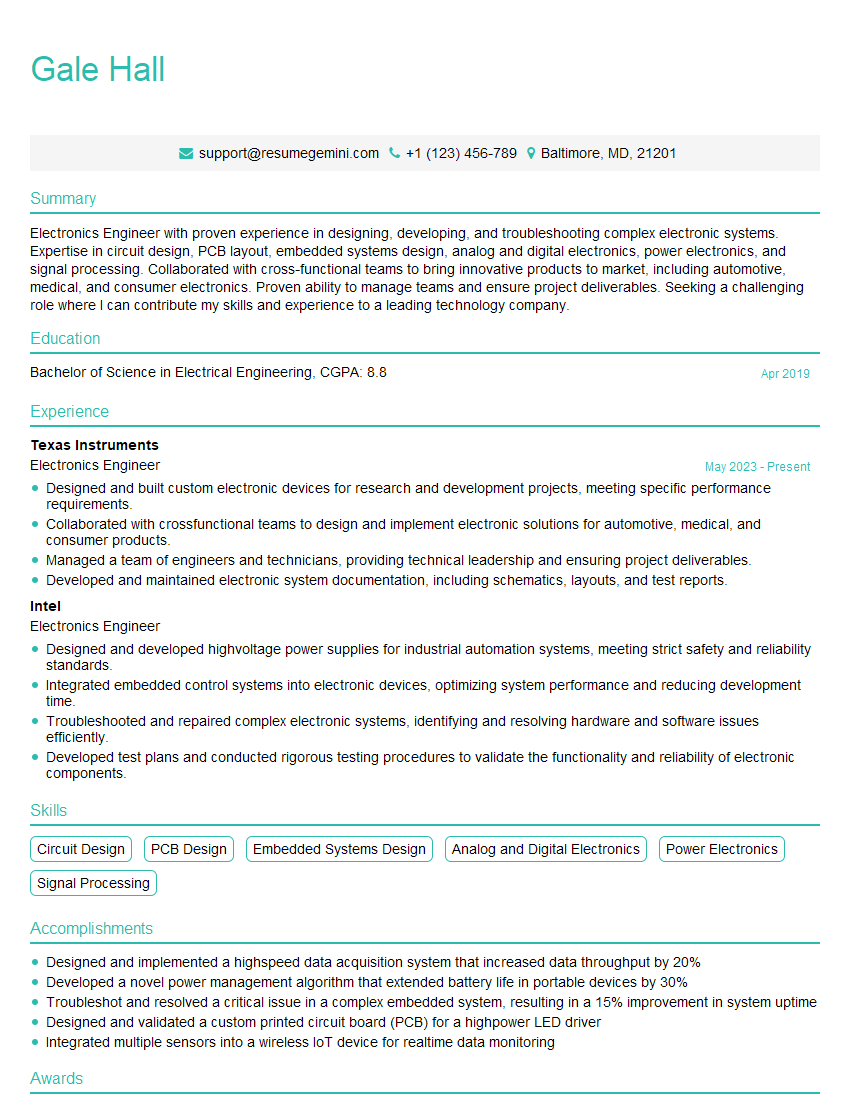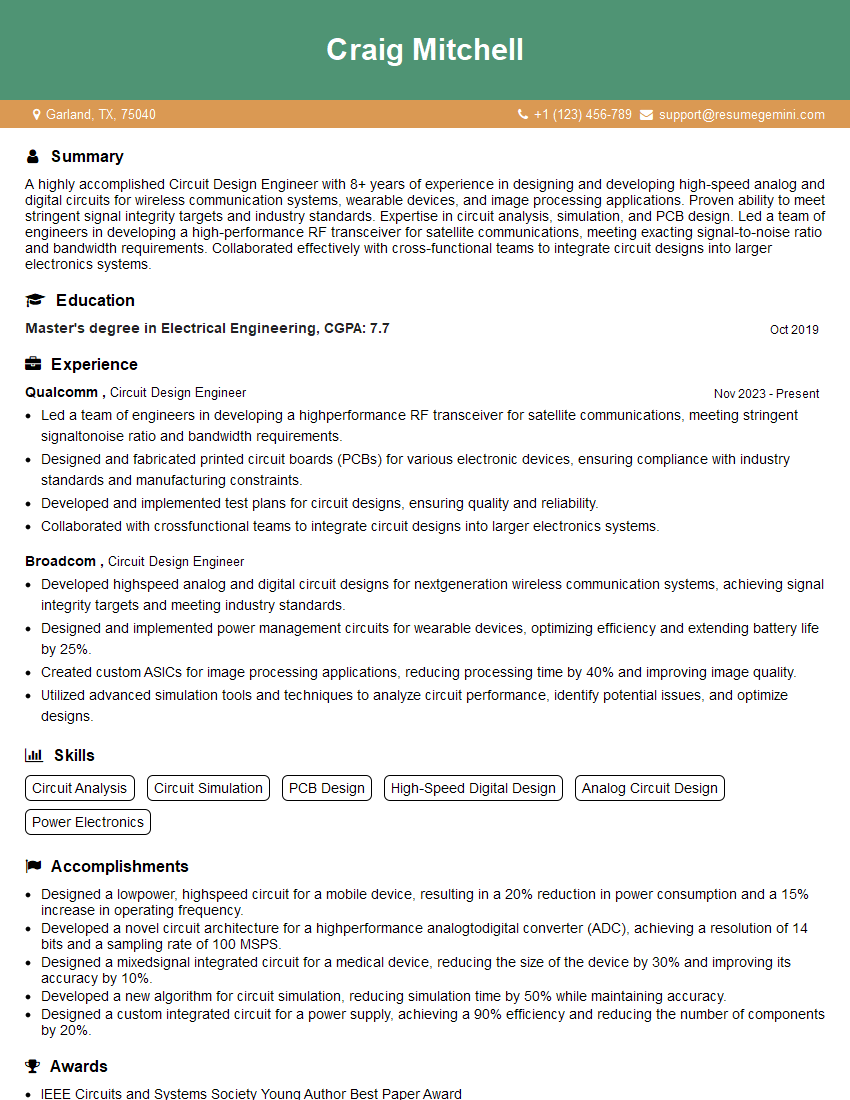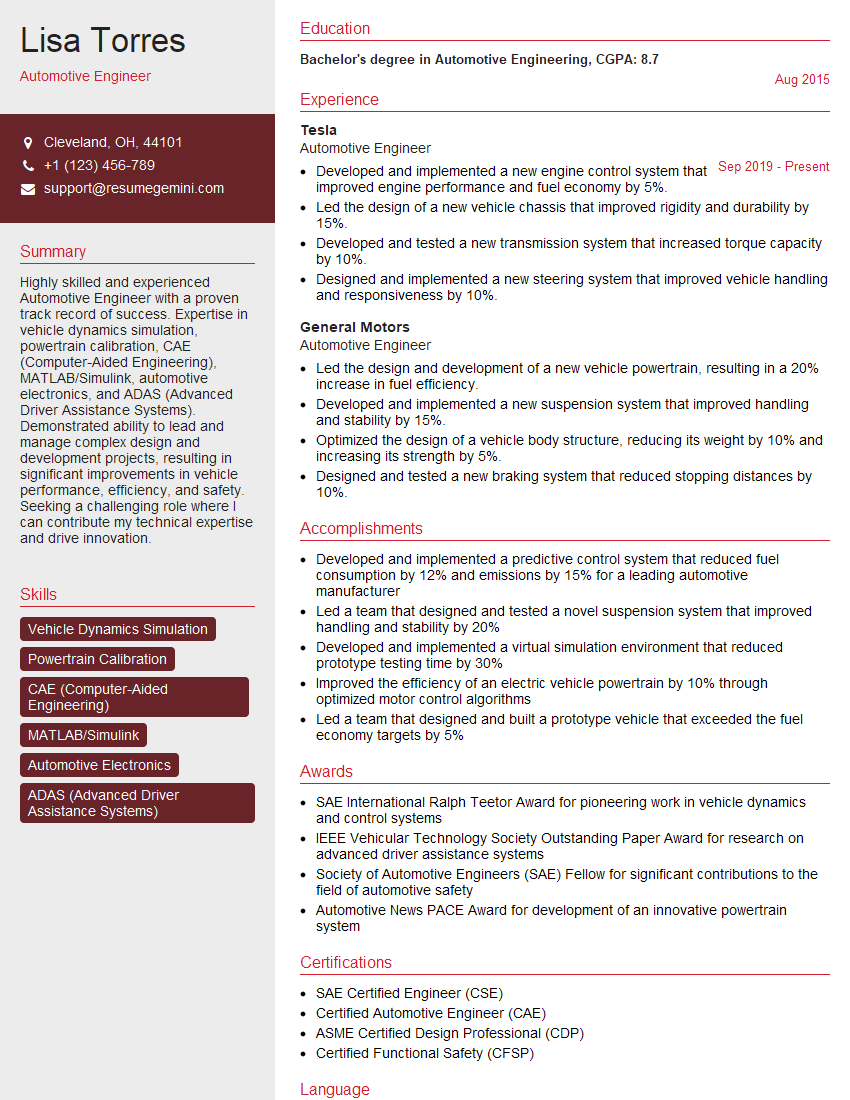Feeling uncertain about what to expect in your upcoming interview? We’ve got you covered! This blog highlights the most important Schematic Diagrams interview questions and provides actionable advice to help you stand out as the ideal candidate. Let’s pave the way for your success.
Questions Asked in Schematic Diagrams Interview
Q 1. Explain the purpose of a schematic diagram.
A schematic diagram is a simplified, symbolic representation of an electrical circuit or system. Think of it as a blueprint for electronics, showing the components and their interconnections without detailing the physical layout. Its primary purpose is to convey the functionality and signal flow of a design, enabling engineers to analyze, understand, and modify the circuit before physical prototyping.
For example, a schematic for a simple light switch would show the power source, the switch itself, and the light bulb, connected by lines representing wires. This allows us to see how the switch controls the flow of electricity to the bulb, regardless of whether the wires are twisted or routed in a particular way on a printed circuit board (PCB).
Q 2. What are the standard symbols used in schematic diagrams?
Standard symbols in schematic diagrams are standardized by organizations like the IEEE (Institute of Electrical and Electronics Engineers) to ensure clarity and universal understanding. These symbols represent common components such as:
- Resistors: Usually a zig-zag line, with values indicated next to it.
- Capacitors: Two parallel lines, representing the plates, with values and sometimes polarity indicated.
- Inductors: A coil, with value indicated.
- Transistors: Symbols vary depending on the transistor type (NPN, PNP, MOSFET, etc.), typically showing terminals (base, collector, emitter).
- Integrated Circuits (ICs): A rectangular block with pins numbered, often with an identifier indicating the IC’s part number.
- Power Sources: Usually a circle with a plus and minus sign indicating positive and negative terminals, often with voltage values.
There are many more specialized symbols for operational amplifiers (op-amps), diodes, connectors, and other components. Schematic capture software usually has a comprehensive library of these symbols.
Q 3. How do you interpret a schematic diagram?
Interpreting a schematic involves tracing the signal flow and understanding the function of each component. Start by identifying the power sources and ground connections. Then, follow the connections between components, analyzing the role of each element in the circuit. Pay close attention to component values (resistance, capacitance, inductance) as they dictate the circuit’s behavior. Look for feedback loops, signal paths, and any special features or functions.
For example, if you see a resistor connected in series with an LED and a power source, you know the resistor limits the current flowing through the LED, preventing it from burning out. Understanding the relationships between components and tracing the signal flow is key to interpreting the schematic’s purpose.
Q 4. What are the differences between a schematic and a PCB layout?
While both schematics and PCB layouts describe the same circuit, they serve distinct purposes. A schematic is a functional representation, focusing on how components interact. A PCB layout is a physical representation, detailing the precise placement and routing of components and traces on a printed circuit board.
- Schematic: Abstract, focusing on functionality; shows connections but not physical location or trace routing.
- PCB Layout: Concrete, focusing on physical implementation; shows component placement, trace paths, layers, and dimensions.
Think of it like this: the schematic is the architectural drawing of a house, while the PCB layout is the detailed construction plan, showing where each brick, wire, and pipe goes.
Q 5. Describe your experience with different schematic capture software.
I have extensive experience with several schematic capture software packages. My proficiency includes Altium Designer, Eagle, and KiCad. Altium Designer is a powerful, industry-standard software ideal for complex designs, offering robust features for library management, hierarchical design, and simulation. Eagle provides a more user-friendly interface suitable for smaller projects and rapid prototyping. KiCad, being open-source, offers a cost-effective alternative with a growing community support and a continually improving feature set. My experience spans from using these tools for small hobby projects to large-scale industrial designs, allowing me to choose the appropriate tool based on the project’s complexity and requirements.
Q 6. How do you handle errors or inconsistencies in a schematic diagram?
Handling errors and inconsistencies in a schematic requires a systematic approach. I begin with a thorough visual inspection, checking for missing connections, incorrect component values, or illogical signal paths. Tools within the schematic capture software, such as design rule checks (DRC), help identify potential problems such as short circuits or open circuits. For more complex issues, I would use simulation tools to verify circuit behavior and identify discrepancies between the intended and actual functionality. Documentation review and collaboration with other engineers are crucial to resolve inconsistencies or ambiguities in the design.
For example, if a simulation reveals unexpected behavior, I would carefully review the schematic, checking component values, connections, and even the model used for each component in the simulation. Often, a simple typo or a misplaced component can cause significant issues.
Q 7. Explain the process of creating a schematic diagram from a design specification.
Creating a schematic from a design specification involves several steps:
- Requirements Gathering: Thoroughly understand the design specifications, including functionality, performance parameters, and any constraints.
- Component Selection: Choose appropriate components based on the specifications and availability. This often involves looking up datasheets and considering factors like power consumption, size, and cost.
- Schematic Capture: Using schematic capture software, create the schematic, placing components and connecting them according to the design specifications. This includes defining component values, labels, and annotations.
- Design Rule Checks (DRC): Run DRC to identify potential errors, such as short circuits or design rule violations.
- Simulation (Optional): Simulate the circuit to verify its behavior and functionality before PCB layout.
- Review and Documentation: Review the schematic with other engineers for feedback and accuracy. Create clear and concise documentation to explain the design and functionality.
This process ensures the resulting schematic accurately represents the design requirements, providing a solid foundation for the PCB layout and subsequent manufacturing.
Q 8. How do you ensure the accuracy and clarity of a schematic diagram?
Ensuring accuracy and clarity in schematic diagrams is paramount for successful project execution. It’s like creating a detailed map – if it’s inaccurate or unclear, you’ll end up in the wrong place! My approach involves a multi-step process:
- Thorough Design Review: Before even starting the schematic, I meticulously review the design specifications, ensuring I completely understand the functionality and interconnections of all components. This prevents fundamental errors early on.
- Consistent Symbol Usage: I adhere strictly to a defined library of symbols, ensuring uniformity and preventing ambiguity. Using a standard library is like using a common language – everyone understands the same symbols and their meaning.
- Clear Labeling and Annotation: Every component, net, and signal is clearly labeled, using a consistent naming convention. I also add annotations where necessary to clarify functionality or special considerations. Imagine adding street names and points of interest to your map!
- Regular Peer Review: I actively encourage peer reviews at multiple stages of the process. A fresh pair of eyes can spot mistakes or areas for improvement that I might have missed.
- Software Validation: I utilize schematic capture software with built-in design rule checks (DRC) to identify potential errors like short circuits or connectivity issues, much like a spell checker for your schematic.
By combining these techniques, I minimize errors and ensure the resulting schematic is accurate, unambiguous, and easily understood by others.
Q 9. What are the best practices for organizing and annotating a schematic diagram?
Organizing and annotating schematic diagrams effectively is critical for readability and maintainability. Think of it as organizing a well-stocked library – you need a system to find what you need quickly.
- Hierarchical Organization: Complex schematics are best organized hierarchically, using sheets and sub-sheets to break down the design into manageable blocks. This is analogous to organizing books by genre and then alphabetically by author.
- Logical Grouping: Components are grouped logically based on their function. This aids understanding and makes modifications easier. For example, all power supply components would be grouped together.
- Consistent Net Naming: A clear and consistent naming convention for nets (signals) is essential. This aids in tracing signals and understanding their function. Using descriptive names helps, like ‘Power_VCC’ instead of simply ‘Net1’.
- Descriptive Annotations: Annotations explain functionality, component selections, or design choices. Think of them as the detailed descriptions you’d find in a library catalog.
- Color Coding: Strategic use of color-coding can further enhance readability. For example, power lines can be red and ground lines black.
- Bus Structures: Using bus structures effectively simplifies the representation of multiple interconnected signals. This reduces clutter and improves readability.
By following these best practices, the schematic becomes a self-documenting design representation, improving comprehension and facilitating collaboration.
Q 10. How do you manage large and complex schematic diagrams?
Managing large and complex schematic diagrams requires a structured approach. It’s like managing a large city – you need a system to handle the scale.
- Hierarchical Design: Breaking down the design into smaller, manageable blocks using hierarchical sheets and sub-sheets is key. This is essential for understanding and modification.
- Schematic Capture Software: Utilizing robust schematic capture software with features like project management, version control, and search functionalities is crucial. Think of this as a sophisticated city planning software.
- Design Rule Checks (DRC): Regular use of DRC helps catch potential errors early on, preventing significant rework later. This is like a city inspector ensuring buildings are up to code.
- Cross-Referencing: Maintaining thorough cross-referencing between sheets and components makes navigation and modification easier. This helps you quickly find the related parts just like cross-referencing streets on a map.
- Team Collaboration: Establishing clear team roles and communication protocols is critical when multiple engineers are working on a large schematic. This facilitates a coordinated city-building project.
By employing these strategies, the complexity of large schematics becomes manageable, promoting efficiency and accuracy.
Q 11. How do you incorporate design changes into an existing schematic diagram?
Incorporating design changes into an existing schematic requires careful planning and execution. It’s similar to renovating a house – you need a detailed plan to avoid causing further damage.
- Impact Assessment: Before implementing any change, thoroughly assess its potential impact on the rest of the design. This ensures that you’re not just patching a hole but rather integrating the change seamlessly.
- Version Control: Always use version control to track changes and allow for easy rollback if needed. This is your ‘before’ and ‘after’ photos when renovating the house.
- Clear Documentation: Document all changes, including the rationale behind them. This helps future engineers understand the evolution of the design.
- Design Rule Checks (DRC): After incorporating any changes, run DRC again to identify any new errors introduced. This is your final inspection to ensure the renovation is safe and structurally sound.
- Testing: Thorough testing of the modified schematic is crucial to ensure the changes haven’t negatively impacted other aspects of the design. This is your trial run before fully moving into the renovated house.
By following these steps, design changes can be implemented smoothly, efficiently, and without unintended consequences.
Q 12. Explain your experience with version control for schematic diagrams.
Version control is indispensable for managing schematic diagrams, particularly in collaborative projects. It is like keeping a detailed history of architectural changes to a building.
My experience includes extensive use of both centralized (e.g., SVN) and distributed (e.g., Git) version control systems. I am proficient in branching, merging, and resolving conflicts. I always ensure that every change is properly documented with clear and concise commit messages, providing context for the modifications made. This allows for easy tracking of changes over time and simplifies collaboration among multiple engineers. The ability to revert to previous versions is a critical safety net, particularly when dealing with complex designs and multiple contributors. I leverage these systems to manage different versions of schematics, track design evolution, and facilitate collaborative development.
Q 13. Describe your process for verifying the correctness of a schematic diagram.
Verifying the correctness of a schematic diagram is a crucial step in the design process. It’s like proofreading a critical document before submission – the consequences of an error are significant.
- Design Rule Checks (DRC): Running DRC helps identify potential electrical errors, such as short circuits, open circuits, and connectivity issues.
- Manual Inspection: A thorough visual inspection is essential, verifying component placement, net connections, and annotation clarity. This is like carefully examining every line and word in your document.
- Simulation: Using circuit simulation tools helps verify the functionality of the design before physical prototyping. This allows for early detection and correction of design flaws.
- Cross-checking with Specifications: Ensuring the schematic aligns perfectly with the design specifications is a critical final step. This confirms that the design meets the intended requirements.
- Peer Review: Having a colleague independently review the schematic provides a fresh perspective and often highlights overlooked errors.
By using this combined approach, confidence is gained that the design is sound and ready for the next stage of development.
Q 14. How do you troubleshoot issues identified during schematic review?
Troubleshooting issues identified during schematic review requires a systematic approach. It’s like diagnosing a car problem – a methodical approach is needed to isolate the root cause.
- Reproduce the Issue: First, attempt to reproduce the issue to ensure consistent results. This is like documenting the car’s symptoms consistently.
- Isolate the Problem Area: Identify the specific area of the schematic where the issue is occurring. This is like narrowing down the potential problem areas in your car.
- Trace Signals: Trace the signals through the schematic, following their path to identify any potential errors in connectivity or component placement. This is like tracing the flow of fluids or electricity through the car’s system.
- Consult Datasheets: Verify that components are used correctly and according to their specifications. This ensures that you’re not overlooking critical component behavior.
- Simulation: Use circuit simulation to test different scenarios and isolate the cause. This is like testing different car components or running diagnostics.
- Review Design Specifications: Check if the design meets the specified requirements. This helps determine if the problem lies in the design itself or in its implementation in the schematic.
By utilizing these troubleshooting methods, issues can be effectively resolved, improving the quality and reliability of the schematic design.
Q 15. How do you work with other engineers to develop and review schematic diagrams?
Collaboration is paramount in schematic design. We typically use a combination of design reviews, version control systems, and communication tools. Initially, I work closely with other engineers to define the system requirements and specifications. Then, we divide the schematic into manageable blocks, assigning ownership to individuals based on their expertise. For example, one engineer might specialize in the power supply, while another focuses on the analog signal processing. We use a version control system like Git to manage different versions of the schematic, ensuring traceability and preventing conflicts. Regular design reviews are crucial, involving all stakeholders, where we discuss the design choices, potential risks, and improvements. Tools like online whiteboards or collaborative design platforms allow us to annotate and discuss the schematic in real-time, making the review process efficient and effective.
For instance, on a recent project involving a high-speed data acquisition system, we used Git to manage the schematic design. Each engineer worked on their designated section, and we held weekly review meetings to discuss the progress, catch errors early, and ensure design consistency. This collaborative approach allowed us to detect and resolve a critical timing issue before fabrication, saving considerable time and resources.
Career Expert Tips:
- Ace those interviews! Prepare effectively by reviewing the Top 50 Most Common Interview Questions on ResumeGemini.
- Navigate your job search with confidence! Explore a wide range of Career Tips on ResumeGemini. Learn about common challenges and recommendations to overcome them.
- Craft the perfect resume! Master the Art of Resume Writing with ResumeGemini’s guide. Showcase your unique qualifications and achievements effectively.
- Don’t miss out on holiday savings! Build your dream resume with ResumeGemini’s ATS optimized templates.
Q 16. Explain your experience with different schematic symbol libraries.
My experience spans several schematic symbol libraries, including those from industry-standard EDA (Electronic Design Automation) tools like Altium, Eagle, and KiCad. Each tool boasts its own library, and I’m proficient in navigating and utilizing their respective strengths. For example, Altium’s library is expansive and well-organized, offering a vast range of components, while KiCad’s library, being open-source, provides flexibility in customizing symbols. Choosing the right library depends on project requirements and team preferences. I’m also experienced in creating custom symbols when necessary, ensuring accuracy and consistency within a project. This often involves using the library’s built-in symbol editors and adhering to the company’s established design standards. Creating custom symbols allows us to represent project-specific components, like a particular vendor’s proprietary IC, with precise accuracy.
For a recent project using a custom ASIC, I had to create a comprehensive custom symbol that included not only the standard pinouts but also internal block representations for better visualization during design review. This improved the overall understanding of the system architecture during the design phase.
Q 17. How do you handle changes in component availability during the design process?
Component obsolescence is a significant challenge in electronics design. My approach involves proactive measures like using preferred parts lists, performing regular component searches using online distributors’ websites, and exploring alternative components with similar specifications. Early in the design phase, I collaborate with procurement to identify potential risks associated with component availability. We also incorporate design for manufacturability (DFM) principles, selecting components with readily available alternatives. If a component becomes obsolete during the design process, I thoroughly evaluate the impact on the circuit’s functionality and explore suitable replacements. This often involves analyzing datasheets, comparing electrical characteristics, and potentially performing simulations to verify that the replacement component meets performance requirements.
In one project, a critical microcontroller became obsolete midway through development. By leveraging my experience and working closely with the procurement team, we identified a pin-compatible alternative with a similar performance profile. After verifying the design with simulation, we successfully completed the project without significant delays or compromising functionality.
Q 18. How do you ensure that your schematic diagram meets industry standards?
Adhering to industry standards is non-negotiable for creating reliable and robust designs. I ensure compliance with standards like IPC (International Printed Circuit) standards for schematic drawing practices, including consistent naming conventions for components, clear annotation, and proper use of designators. These standards promote clarity, readability, and maintainability of the schematic. Furthermore, I utilize the schematic design tools’ built-in design rule checks (DRC) to identify potential issues like naming conflicts or incorrect component placements early on. Regular reviews by senior engineers, who often have extensive experience in design standards, also contribute to maintaining high standards.
For example, I always use a consistent naming convention for components (e.g., R1, C2, U3) that aligns with IPC standards. This ensures that the schematic is easy to understand and maintain, simplifying collaboration and manufacturing processes.
Q 19. Describe your experience using simulation software to verify circuit function.
Simulation plays a crucial role in verifying circuit function before physical prototyping. I’m proficient in using simulation software like LTSpice, PSIM, and Multisim to perform various analyses, including transient, AC, and DC simulations. These simulations help to validate the circuit’s performance under different operating conditions. Before running a simulation, I carefully construct the schematic within the software, ensuring all components are accurately represented and the simulation settings are correctly configured. The results from the simulation are then meticulously analyzed to identify potential design flaws or areas for improvement. This iterative process of simulation and refinement is crucial to reduce errors and ensure optimal performance.
During a recent project involving a high-frequency amplifier, simulation helped me to identify an unexpected oscillation that was not apparent from the initial schematic. Using LTSpice’s transient analysis, I was able to pinpoint the cause and implement a solution to stabilize the amplifier, saving significant time and resources during the prototyping phase.
Q 20. How do you identify and resolve potential issues with signal integrity in a schematic diagram?
Signal integrity issues can significantly impact circuit performance. I address them by considering several aspects, including impedance matching, minimizing trace lengths, using appropriate decoupling capacitors, and strategically routing signals to minimize cross-talk. Using simulation software helps to analyze signal reflections, propagation delays, and crosstalk. For example, I’d use SPICE simulations to model the effects of different trace lengths and capacitor values on signal integrity. High-speed designs often require specialized analysis, which may involve using specialized simulation tools like IBIS-AMI models, providing a more realistic representation of components’ high-speed behavior.
In a previous project with a high-speed digital interface, simulation revealed a significant signal degradation due to inadequate impedance matching. By adding appropriate termination resistors and optimizing trace routing, we eliminated the problem and ensured the reliable transmission of data.
Q 21. What are the common design rules for creating effective schematic diagrams?
Creating effective schematic diagrams involves following several design rules. These rules are guided by the principles of clarity, readability, and maintainability. Key design rules include:
- Consistent naming conventions: Using a standard system (e.g., R1, C2, U3) for components.
- Clear and concise annotation: Providing sufficient information about the circuit’s functionality without clutter.
- Hierarchical organization: Breaking down complex circuits into smaller, manageable blocks.
- Logical layout: Arranging components in a way that reflects the signal flow.
- Use of appropriate symbols: Selecting symbols that clearly represent components and their connections.
- Proper use of nets: Clearly defining signal connections.
- Consistent use of busses: Grouped wires representing multiple signals.
Think of a well-drawn schematic like a well-written paragraph; it should be easy to read, logically structured, and immediately conveys the key information. A poorly-organized schematic can be incredibly frustrating to work with and can contribute to costly errors down the line.
Q 22. Explain your experience with netlist generation and its importance.
Netlist generation is the process of creating a text file that describes the interconnected components of a schematic diagram. It’s essentially a translation of the visual schematic into a machine-readable format. This is crucial for downstream processes like PCB design, simulation, and manufacturing. Think of it like translating a recipe (schematic) into a precise list of ingredients and their quantities (netlist) for a chef (manufacturing equipment) to follow.
My experience involves using various Electronic Design Automation (EDA) tools to generate netlists in formats like SPICE, netlist, and others depending on the needs of the project and the targeted manufacturing process. For instance, in one project involving a high-speed digital design, we used a netlist generated from Altium Designer to run signal integrity simulations using HyperLynx. The accuracy of the netlist directly impacts the accuracy of the simulation results, which is critical for ensuring the design meets its performance goals.
The importance of a clean and accurate netlist cannot be overstated. Errors in the netlist lead to errors in the PCB layout, potentially resulting in malfunctioning hardware, costly revisions, and project delays. A well-generated netlist significantly reduces the risk of these issues and streamlines the entire design process.
Q 23. How do you incorporate feedback from design reviews into your schematic?
Incorporating feedback from design reviews into a schematic is an iterative process requiring careful attention to detail. We usually start with a formal design review session where the schematic is presented, and each team member offers their input. This feedback can range from minor corrections in component values to major architectural changes.
I use a version control system (like Git) to manage changes. After a design review, I update the schematic based on the accepted feedback, annotating each change with a clear description. This ensures traceability and helps avoid confusion during subsequent reviews. For example, if a component needs to be replaced, I not only make the change but also add a comment explaining the reason for the change, referencing the design review notes or any relevant documentation. This meticulous documentation is critical for collaboration and transparency.
Furthermore, I believe in open communication. If I’m unsure about a suggested change, I engage in a discussion with the design review team to fully understand the reasoning behind the feedback before implementing it. This collaborative approach ensures that the final schematic is robust, efficient and reflects the collective expertise of the team.
Q 24. How do you ensure the manufacturability of a design based on its schematic?
Ensuring manufacturability relies on considering various factors from the schematic stage itself. It’s not just about drawing the circuit; it’s about designing for ease of fabrication. This involves selecting components readily available from reliable suppliers, considering their physical dimensions and tolerances, and ensuring the design is compatible with the chosen manufacturing process (e.g., surface mount technology (SMT), through-hole technology).
For example, I avoid using obsolete components or those with tight tolerances that could cause difficulties during assembly. I also prioritize standard component packages whenever possible, as they are more readily available and cost-effective. Moreover, I pay close attention to design rules, like minimum clearances between components to prevent shorts or solder bridging. These rules are often provided by the manufacturing house and need to be incorporated in the schematic to avoid costly mistakes down the line. This proactive approach saves time and money by preventing design changes during the PCB layout and manufacturing phases.
Using EDA software with built-in design rule checks (DRC) is essential. These tools highlight potential manufacturability issues early on, before the design proceeds to the PCB layout stage. This early detection allows for immediate corrections, saving significant time and resources.
Q 25. Describe a challenging schematic diagram you worked on and how you overcame the challenges.
One challenging schematic involved a high-power, high-frequency switching power supply. The main challenge was managing the high-voltage and high-current components while maintaining EMI/EMC compliance. The initial design suffered from significant voltage spikes and unexpected oscillations due to parasitic inductances and capacitances. The high frequencies involved exacerbated these issues.
To overcome these challenges, I employed several strategies. Firstly, I meticulously modeled the parasitic components using appropriate simulation tools and refined the layout to minimize their impact. This involved a thorough understanding of transmission line effects and careful placement of components to minimize loop areas and signal path lengths. Secondly, I added appropriate decoupling capacitors and snubber circuits to damp voltage spikes and oscillations. Thirdly, we performed extensive simulations using SPICE-based software to validate our design changes and ensure the design met the performance specifications before proceeding to the prototype stage.
The successful resolution involved a blend of theoretical knowledge, simulation skills, and iterative refinement. The final design exhibited much improved stability and met all specifications, highlighting the importance of diligent design practices and problem-solving skills in tackling complex schematic challenges.
Q 26. Explain your experience with hierarchical schematic design.
Hierarchical schematic design involves breaking down a large and complex schematic into smaller, more manageable sub-circuits. Each sub-circuit is designed and documented separately, then integrated into the higher-level schematic. This modular approach significantly improves design organization, readability, and reusability. It’s similar to constructing a building; instead of designing the entire structure at once, you break it down into floors, rooms, and smaller components, making the entire process less overwhelming and more efficient.
My experience includes extensively utilizing hierarchical design techniques in projects involving complex embedded systems and high-density PCBs. This approach allows for better collaboration among team members, as different parts of the design can be assigned to individual engineers. Furthermore, it simplifies debugging and maintenance because problems are easier to isolate and solve within smaller, well-defined blocks. Changes made to a sub-circuit can easily be tracked and propagated throughout the system. Efficient use of schematic sheets is also a benefit, as complex diagrams are organized into logical sub-units. Altium Designer, for example, provides robust support for hierarchical schematic design, allowing seamless integration and management of multiple levels within the schematic.
Q 27. How do you ensure the security and confidentiality of schematic diagrams?
Securing schematic diagrams is paramount. They represent intellectual property and could have significant commercial value. My approach involves a multi-layered security strategy. This includes restricting access to the schematic files to authorized personnel only using access control lists and robust password management systems.
We employ version control software like Git, not only for managing design changes, but also to ensure proper backup and audit trails. Furthermore, sensitive schematics are often stored on secure servers with encryption and regular data backups. For particularly sensitive designs, we may even use digital rights management (DRM) to control access and prevent unauthorized copying or distribution. Watermarking schematics with company logos and unique identifiers is another layer of protection.
Moreover, we have strict internal policies regarding the handling and dissemination of schematic diagrams. Training is provided to all team members on the importance of data security and the procedures to follow. Regular security audits are conducted to ensure the effectiveness of our security measures and identify potential vulnerabilities.
Key Topics to Learn for Schematic Diagrams Interview
- Fundamentals of Schematic Capture: Understanding the purpose and different types of schematic diagrams (e.g., electrical, mechanical, process flow). Mastering the basics is crucial for building a solid foundation.
- Component Symbol Libraries and Design Rules: Learn how to effectively utilize component libraries and adhere to design rules for creating clear and accurate schematics. This demonstrates attention to detail and adherence to industry standards.
- Hierarchical Design and Netlisting: Explore the concepts of hierarchical design and netlisting, and how these techniques are applied in complex projects. Understanding this showcases your ability to manage large-scale projects efficiently.
- Schematic Editing and Revision Control: Practice efficient schematic editing techniques and understand the importance of version control in collaborative projects. This emphasizes your ability to work effectively within a team.
- Practical Applications: Consider various applications of schematic diagrams across different engineering disciplines. Examples include PCB design, system architecture visualization, and process flow analysis. This shows a broad understanding of the subject’s relevance.
- Troubleshooting and Problem Solving: Develop strategies for identifying and resolving errors within schematic diagrams, such as short circuits or incorrect component placement. This demonstrates practical skills and analytical thinking.
- Software Proficiency: Familiarize yourself with commonly used schematic capture software (mentioning specific software names is optional, focusing on general skills is better). Showcase your proficiency in using these tools to create and manage complex designs.
Next Steps
Mastering schematic diagrams is a valuable skill that significantly enhances your career prospects in various engineering fields. It demonstrates a strong understanding of design principles and technical problem-solving abilities, leading to increased job opportunities and career advancement. To stand out, create an ATS-friendly resume that highlights your relevant skills and experience effectively. Leverage ResumeGemini to build a professional and impactful resume that catches the recruiter’s eye. ResumeGemini provides examples of resumes tailored to roles involving Schematic Diagrams, helping you craft a winning application.
Explore more articles
Users Rating of Our Blogs
Share Your Experience
We value your feedback! Please rate our content and share your thoughts (optional).
What Readers Say About Our Blog
Hello,
We found issues with your domain’s email setup that may be sending your messages to spam or blocking them completely. InboxShield Mini shows you how to fix it in minutes — no tech skills required.
Scan your domain now for details: https://inboxshield-mini.com/
— Adam @ InboxShield Mini
Reply STOP to unsubscribe
Hi, are you owner of interviewgemini.com? What if I told you I could help you find extra time in your schedule, reconnect with leads you didn’t even realize you missed, and bring in more “I want to work with you” conversations, without increasing your ad spend or hiring a full-time employee?
All with a flexible, budget-friendly service that could easily pay for itself. Sounds good?
Would it be nice to jump on a quick 10-minute call so I can show you exactly how we make this work?
Best,
Hapei
Marketing Director
Hey, I know you’re the owner of interviewgemini.com. I’ll be quick.
Fundraising for your business is tough and time-consuming. We make it easier by guaranteeing two private investor meetings each month, for six months. No demos, no pitch events – just direct introductions to active investors matched to your startup.
If youR17;re raising, this could help you build real momentum. Want me to send more info?
Hi, I represent an SEO company that specialises in getting you AI citations and higher rankings on Google. I’d like to offer you a 100% free SEO audit for your website. Would you be interested?
Hi, I represent an SEO company that specialises in getting you AI citations and higher rankings on Google. I’d like to offer you a 100% free SEO audit for your website. Would you be interested?
good

